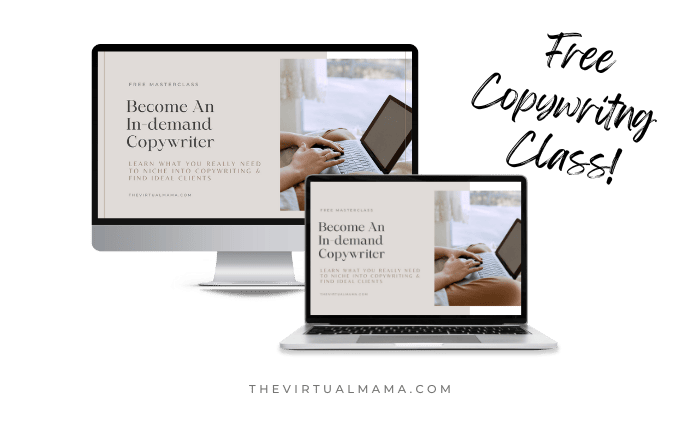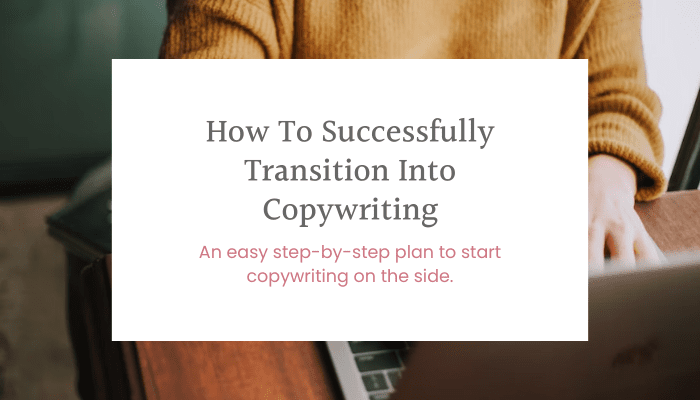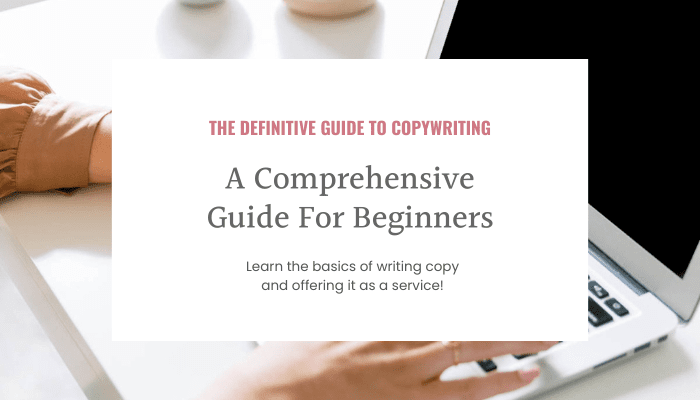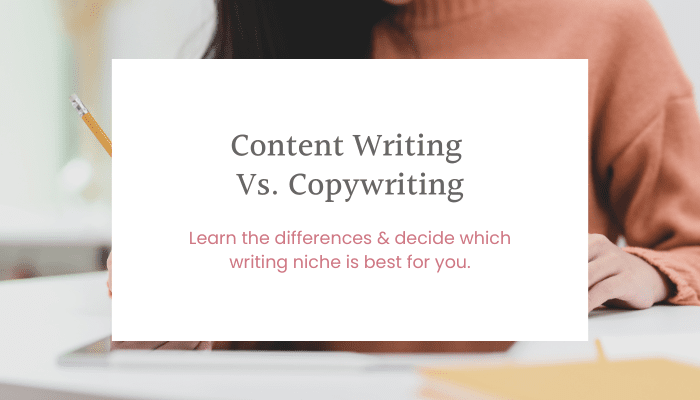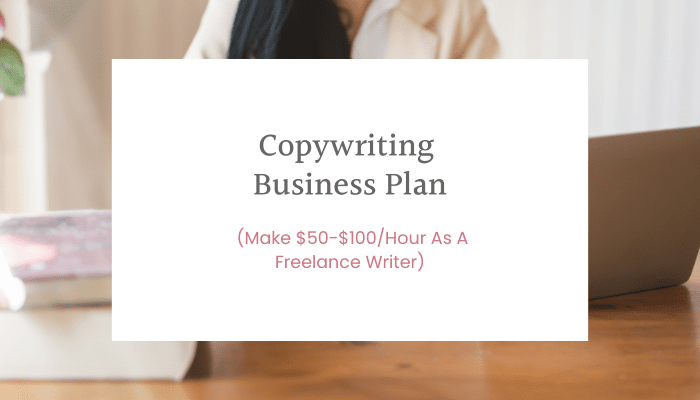How Much To Charge For Email Copywriting (Complete Guide)
Learn exactly how much to charge for email copywriting (whether you’re new or experienced).
Table of Contents
Today I’m going to show you exactly how much to charge for email copywriting.
In fact, this is the same pricing method I use in my agency to price our services for client proposals.
Whether you’re just starting out or have been offering copywriting for a while, this guide will make it easy to adjust your method based on your skill and experience level.
Let’s get started!
What Is Email Copywriting?

Email copywriting is the process of writing an email to a list of subscribers with the intent of getting the reader to take a desired action.
The Emails are short pieces of copy, usually under 500 words.
Writing emails is a great service for new and seasoned copywriters alike. The best part about it is that it’s a recurring service, so it can bring in consistent revenue for your business.
Even if you don’t consider yourself a copywriter, you can still offer this as part of email marketing services in your virtual business.
Whether your goal is to connect with your audience or persuade a potential client to consider your brand, emails are a great marketing tool for your own business too.
Emails are also an effective way to:
- Nurture your audience
- Build strong customer relationships
- Launch a new product or service
- Share testimonials or case studies
- Share behind the scenes of your business
Types Of Email Copywriting
Weekly Newsletters
A newsletter is an email sent on a consistent basis to nurture your relationship with your audience. The frequency varies from one business to another but can be sent out multiple times a week, once a week, bi-weekly, or monthly.
Like with any genuine relationship, there is always something that piques your interest to want to learn more. A newsletter gives your audience an exclusive behind-the-scenes look into your world by sharing your latest tips, news, or updates relating to your business.
Here’s an example of a past newsletter I sent.
If you’d like to subscribe to my newsletter and see more examples you can do so here 👇
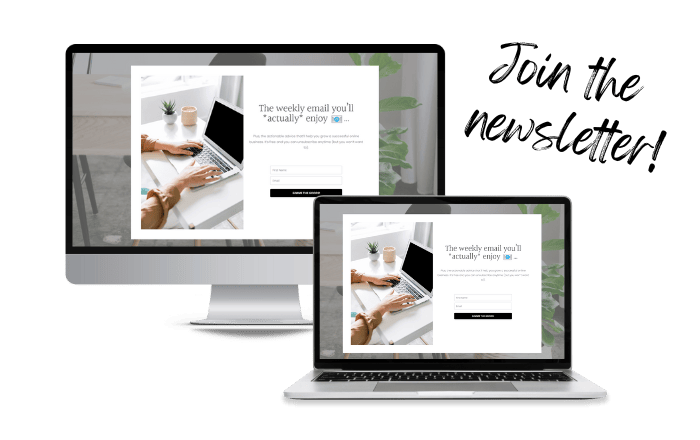
Email Sequences
What if you could keep all of your customers engaged and help guide their decision in choosing your product, service, or brand?
This is not always an easy task, but an email sequence can help you do just that.
The best part is you only have to set it up once!
An email sequence is a series of emails that are automatically sent to specific groups or “segments” of people on your email list when a certain action is taken (like signing up for your newsletter).
This sequence can be “trigger-based” or “time-based.”
Trigger-based emails depend on the actions of the subscribers such as:
- Subscribing to your list
- Buying a product
- Clicking on a link
Time-based email sequences send emails at a set time like:
- Immediately after an opt-in
- A specific amount of days, weeks, or months since a user has subscribed
You can read my welcome email sequence by signing up for my free copywriting guide. (Once you sign-up, you’ll get the emails in your inbox over the course of several days.)
Sales Emails
A sales email is a type of “sales letter” used to introduce a product or service to a prospective customer with the intention of getting the reader to buy.
Market research from sources like Forbes, Constant Contact, and HubSpot says the average return on sales emails is between $36 – $42 for every dollar invested.

That type of return is worth your time and effort.
Here is an example of a sales email from my course launch.
Other Email Examples
Other types of emails include:
Cold pitch emails – These are emails sent to prospects who have never heard about your product or service before.
Prospecting emails – These emails are sent to prospective customers who are aware of your offers or have shown interest. The goal is to nurture and engage with them so they will buy from you.
Welcome emails – This is a series of emails introducing a new user to your brand.
Win-back emails – These emails re-engage subscribers who haven’t interacted with your emails.
The Basics Of Writing Email Copy
Whether you want to write email copy for your own business or offer this as a service to your clients, you can learn how to write effective emails by learning copywriting principles and studying great email campaigns.
Let’s dive into the key elements of great emails and everything you need to get started writing them.
The Anatomy Of A Successful Email
There is only ONE factor that determines the success of an email, and that is this…
Did it accomplish its goal?
Before you write, you need to decide what the purpose of the email is to know whether or not it was successful.
Here are other factors that’ll help your email accomplish its goal:
- A juicy, compelling subject line (this affects open rates)
- A great opening hook to keep subscribers reading
- Focusing copy on the reader, not the business you’re promoting (start as many sentences as possible with the word “you” rather than using “I”)
- Every word should serve a purpose – the more concise the better!
- It ends with a clear call to action – make it easy for the reader to take the next step!
Before sending out any email, always ask yourself…
Did this email interest me? Would I open and read this?
If the answer is “no,” then it’s likely subscribers won’t be interested either. This is a great way to test any email you write!
3 Techniques To Write Powerful Emails
Writing emails becomes easy when you don’t start from scratch. That’s why as a copywriter, I like to use copywriting formulas as a starting point..
Inside my copywriting course I cover this in-depth, but today I will share three of my favorite formulas. One of them I created myself and usually ONLY share with my copywriting students – but you’re going to learn what it is shortly. Enjoy 🙂.
Story, Segue, Sell™
This is a signature copy formula I created to quickly write engaging sales emails. First, hook subscribers with a fascinating story, then segue into the point of your message and sell them on the call-to-action.
Story-based copy is a powerful way to connect with your audience and humanize your business.
Pain, Agitation, Solution
This is truly a go-to formula for copywriters. You begin by talking about the audience’s problem, then agitate that problem even more, and present the solution to the problem (which would be tied to the call-to-action).
Attention, Interest, Desire, Action
You begin your copy with something that will hook your reader’s attention instantly. Second, you state something that arouses more interest. Then, make the reader desire the offer—make them feel like they just have to have it. Last, show them the action they should take.
What You Should Know About Subject Lines
Subject lines are the equivalent of a headline to your email copy. They play a huge role in whether or not a reader will open your email.

Think about it like the title of a book. For many people, it’s what will help them determine if they even want to pick it up to read the summary.
While there are different factors that affect whether or not someone will open your email, one of the biggest determining factors is if they’re interested in your subject line.
Your subject line should always be relevant to your email body copy while piquing the interest of your subscribers.
To learn more about writing email copy (that people actually enjoy), watch this LIVE training inside my free Facebook group. I shared a formula for writing spicy email copy that subscribers will love!
(Once you request to join, you’ll be approved and can watch the video)
How To Offer Email Copywriting Services
Do you want to add email copywriting as a service you offer in your business?
I’ll walk you through the exact steps you need to take to start…
Step 1: Learn Basic Copywriting Principles
The most important thing you need to do before transitioning to copywriting is to learn how to write copy.
I have a free copywriting class that’ll get you started.
Here are a few extra tips that will help:
Know your audience. Identify their problems and learn to think like them.
Write compelling headlines. Don’t waste any time—make sure you hook your reader right away.
Have a clear call to action. Remember, the call to action (or “CTA”) is the next step you want the reader to take after reading your copy.
Improve your skills. Invest in resources that’ll help you become an in-demand copywriter.
Create a process for your projects. This helps build trust with potential clients.
If you want to learn the ins and outs of email marketing, check out my email marketing training, List Lingo™.
Step 2: Practice & Create Samples
The more you practice, the better your email copy will be (and the better conversions you’ll get).
Before witing email copy for clients, give yourself time to find sample emails to study, take courses, and even explore the emails you already have in your inbox.
Chances are you’ve already subscribed to some blog, email list, newsletter, freebie, or course that can give you inspiration.
Compare what you found and see which emails engaged you or got you to take action.
Below is a related episode from my podcast, Business In His Image. I shared how to write engaging email copy and keep users subscribed. These are the same tips I use for my copywriting clients and my own business ⬇️
Step 3: Learn Your Industry
You don’t have to niche down right away, but understanding the kind of businesses you plan to write emails for will help you be prepared.
For example, there’s a big difference between writing emails for a course creator and an e-commerce business.
While copywriting principles remain the same, you want to study examples in the industry you’re going to write for.
Conduct industry research – Save any information you find that you might want to use later from different sources, websites, job descriptions, articles, etc.
Do a competitive analysis – You can search for businesses using Google, Facebook, customer reviews job sites, or ads from the brands you follow. Then, research competitors to make comparisons. This is a great way to discover trends and patterns.
Find experts in the industry – Search for popular books, podcasts, YouTube videos, or courses from experts in the industry you’re writing for.
Step 4: Start With Existing Clients
When reaching out to existing clients, start with these steps ⬇️
- Make a list of your best clients, repeated customers, or past colleagues who are well-connected.
- Send them a personalized email highlighting what makes their business special, and how you have enjoyed working with them. Remember to mention that you’re open to referrals.
(When my husband and I launched our agency, honeyDIGITAL I sent a personalized email to people in my network.)
- Remember to include your unique promise or value proposition.
- Don’t forget to share an expected follow-up date and contact information.
If you don’t have a list of existing clients, you can still cold-pitch your services. You can learn more about cold pitching in this affordable workshop here. I’ll also share some key tips later in this post.
How Much To Charge For Email Copywriting
Ok, let’s get down to business. You want to know how much you should actually charge for email copywriting services…
It can be a challenge to find the right price point to attract clients while still being fair to yourself.
The truth is that there is no one-size-fits-all answer to what you should charge for email copywriting. Your rate will depend on a variety of factors, including:
- Experience level
- Project scope
- Skill
While these rates can vary from one copywriter to another, let’s break that down further…
Rates For Weekly Newsletters
This is a weekly, bi-weekly, or monthly email that’s sent to subscribers to nurture and build trust. They can range from $50-$150+ per email.
Rates For Sales Emails
This is essentially a sales letter in your inbox! The purpose is to drive conversions and increase sales. You can charge anywhere from $50-$400+ per sales email. (Remember that clients will profit from your sales copy!)
Rates For Sales Sequences
A sales sequence is a series of emails that sell a product or service. They’re typically 5-7 emails long, but can be longer (I’ve written sequences with 20+ emails).
Sales sequence rates can range from $250-$2,500+ per sequence depending on a number of factors like your skill, experience, and scope of the strategy, research, and planning being done for the project.
Rates For Nurture Sequences
This is a series of emails that engage and nurture a subscriber list. Nurture sequence rates can range from $250-$1,500+ per sequence.
Here’s a chart you can save for reference:
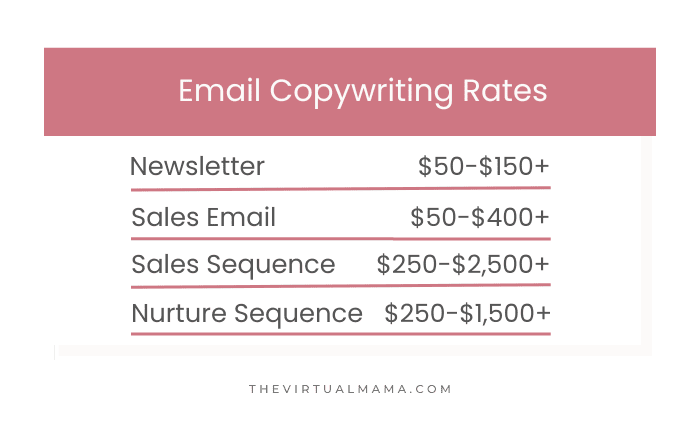
Check out the live video below to learn how you can earn more with your copywriting services!
How To Find Email Copywriting Clients
You can clearly see how profitable email copywriting can be as a service! If you’re interested in specializing as an email copywriter, here are some tips to find email copywriting clients.
Ask Your Network
Most people don’t know how to write copy, so you can become a go-to resource for people in your network.
Start talking about what you do with others, and share your expertise to help other entrepreneurs with their businesses.
Simply letting your network know about your services is the easiest and fastest way to get potential leads.
You never know who in your network actually might need help with copy for their business (and if they don’t, they might know someone who does).
Cold Pitch Your Services
Cold pitching is how I got my first client, and it’s what I recommend for new copywriters as well.
Most people don’t like to hear that advice. They’d rather have a bunch of ideal clients chasing them down (wouldn’t we all?).
But here’s the thing…
You can get to that point, but in the beginning, you have to market yourself.
Do a little research on Google, and find businesses in the industries you’d like to write for one day.
If you need ideas, check out my list of 100 Client Niches For Copywriters.
You can also learn how to craft the perfect pitch inside my Cold Pitch Workshop where I spill all the tea on how I personally landed clients (with exact scripts) ⬇️
Connect With Other Business Owners
Most entrepreneurs do networking all wrong. The key is building relationships, and not just pitching your services.
I always suggest going into a new relationship without any expectations, and just focusing on giving value and getting to know the other person.
I recommend connecting with 3 business owners that you want to develop professional relationships with and meeting bi-weekly or monthly (even if it’s virtually).
Some other things you can do include:
- Send cold emails to 5 businesses
- Add 5 new connections on LinkedIn
- Add 5 new connections on Facebook groups
- Search for 2 local meetups a month in your area
Conclusion
If you want to specialize as an email copywriter, you’re in great company! Email copy is a profitable specialty that you can become known for in any industry because every business needs it! I hope this guide gave you a great foundation for what to charge for your email copywriting services.
Related articles
How To Write A Copywriting Proposal (Free Template)
How To Successfully Transition Into Copywriting (Step-By-Step Plan)
How To Write Copy & Find Ideal Clients Step-by-Step


